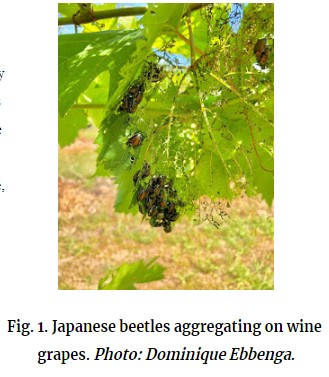By Dominique Ebbenga, Eric Burkness, Matt Clark & Bill Hutchison
Japanese beetle (Popillia japonica) is an invasive species first detected in Minnesota in 1968. While the insect has been in Minnesota for about 50 years, its population density has been relatively low statewide, with significant numbers building in just the past 3-5 years. In recent years, Japanese beetle (JB) populations have been increasing significantly, primarily in the southeast, south-central regions of the state, but particularly in the 7-country metro.

Fruit and growers have noticed heavy infestations on a variety of crops, including: raspberry, blueberry, apples, plums and wine grapes. The recent “onslaught” of JB on these crops has raised new concerns and questions such as:
What economic or “action” thresholds are available for growers to use in making management decisions? Are there biological control options available for JB? What insecticides or organic options are available?
UMN Entomologists Study Japanese Beetles
New research proposals are being submitted this winter to begin to answer these and other questions, and then help build sustainable integrated pest management (IPM) solutions. In the meantime, however, our research and extension team has been active in collecting preliminary data during 2017-2018, to begin to address some of the IPM questions.
In this article, we present some encouraging results regarding varietal differences in resistance to JB that can be useful in helping growers plan ahead with variety selection.